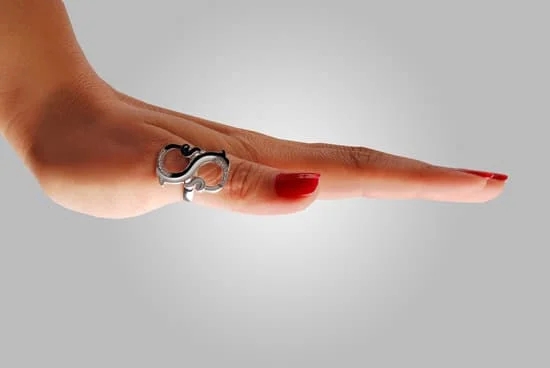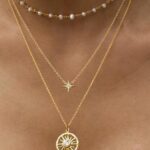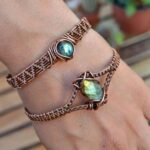Diamond dust is a dazzling and exquisite material that can take your jewelry to new heights of elegance and brilliance. It is a fine powder composed of crushed diamonds, known for its reflective properties and ability to enhance the appearance of any piece of jewelry. In this article, we will explore the world of diamond dust and how it can be applied to jewelry in order to elevate its beauty.
Diamond dust has been utilized in the jewelry industry for various purposes. One of its main uses is as a coating material for enhancing the sparkle and shine of gemstones. By applying a thin layer of diamond dust onto the surface of a jewel, it creates a mesmerizing effect that captures and refracts light, resulting in an unparalleled radiance.
Beyond its visual appeal, diamond dust also provides protection for jewelry by creating a durable layer on the surface. This helps prevent scratches, tarnishing, and other forms of damage over time. Moreover, diamond dust can be mixed with clear coatings or adhesives to create customized finishes or embedments on jewelry pieces.
Applying diamond dust to jewelry offers numerous benefits, whether you have a cherished heirloom piece that needs revival or simply want to add some extra sparkle to your collection.
In the following sections, we will delve deeper into the process of preparing your jewelry surface, selecting the right type of diamond dust, necessary tools and materials needed, step-by-step application guide, achieving different effects with diamond dust, tips and tricks for success, caring for jewelry with diamond dust, and embracing the brilliance that this technique brings.
Whether you are an experienced jeweler or someone who loves DIY projects, this article will equip you with all the information you need to transform your precious pieces into stunning works of art using diamond dust. Get ready to uncover the secrets behind this magical substance and bring out the true radiance in your favorite jewelry.
Importance of Preparing the Jewelry Surface
Preparing the surface of the jewelry before applying diamond dust is a crucial step in achieving optimal results. Proper preparation ensures that the diamond dust adheres well to the jewelry and enhances its appearance. Here are some steps to follow for preparing the jewelry surface:
- Clean the Jewelry: Before starting the preparation process, make sure to thoroughly clean the jewelry piece. Use a mild soap and warm water solution to remove any dirt, oils, or residues that may be present on the surface. Gently scrub with a soft brush or cloth to ensure all areas are cleaned.
- Polish the Jewelry: After cleaning, it is essential to polish the jewelry to smoothen its surface. This will help create a flawless base for applying diamond dust and allow it to adhere properly. There are various polishing methods available depending on the material of your jewelry (e.g., metal, gemstone). Choose a suitable polishing method and use appropriate tools like polishing pads or cloths.
- Remove Existing Coatings: If your jewelry has any existing coatings like lacquer or varnish, it is crucial to remove them before applying diamond dust. These coatings can prevent proper adhesion and affect the final result. Use an appropriate solvent or remover recommended for your specific type of coating and follow instructions carefully.
By following these steps, you will ensure that your jewelry surface is properly prepared for applying diamond dust. This will enhance the overall appearance of your jewelry piece and allow the diamond dust to shine vibrantly.
| Steps for Preparing Jewelry Surface |
|---|
| 1. Clean the Jewelry |
| 2.Polish the Jewelry |
| 3.Remove Existing Coatings |
Selecting the Right Diamond Dust
When it comes to applying diamond dust to jewelry, selecting the right type of diamond dust is essential in achieving the desired results. There are various types of diamond dust available in the market, each with its own unique properties and characteristics. Here are some factors to consider when choosing the appropriate diamond dust for specific jewelry pieces:
- Coarseness: Diamond dust comes in different levels of coarseness, ranging from fine to coarse. Finer diamond dust is ideal for delicate and intricate jewelry pieces, as it allows for a more subtle sparkle. On the other hand, coarser diamond dust can create a bold and eye-catching effect on larger jewelry pieces.
- Color: Diamond dust is available in a range of colors, including white, pink, blue, and green. The color you choose should complement the metal or gemstone of the jewelry piece. For example, white diamond dust pairs well with silver or platinum jewelry, while colored diamond dust can add a pop of vibrancy to yellow gold or gemstone pieces.
- Adhesive Compatibility: It’s important to ensure that the adhesive you use to attach the diamond dust is compatible with both the dust itself and the material of your jewelry. Some adhesives may react with certain types of diamond dust or metals, causing damage or discoloration.
- Longevity: Consider how long you want the diamond dust to last on your jewelry piece. Some types of diamond dust are designed for temporary applications and may wear off over time or during cleaning. Others are more durable and can withstand regular wear without losing their sparkle.
To make an informed decision, it’s recommended to consult with jewelers or experts who have experience working with diamond dust. They can provide guidance based on your specific needs and preferences.
Tools and Materials Needed
To apply diamond dust to jewelry, there are several tools and materials that you will need. Each item plays a crucial role in ensuring the successful application of diamond dust and achieving the desired effect on your jewelry pieces.
- Jewelry Cleaning Solution: Before applying diamond dust, it is important to clean the jewelry to remove any dirt, oils, or residue that may affect the adherence of the diamond dust. Use a gentle jewelry cleaning solution that is specifically designed for the type of metal or gemstone in your jewelry.
- Soft Cleaning Cloth: A soft cleaning cloth is essential for drying and polishing your jewelry after cleaning. It should be lint-free and made of a non-abrasive material such as microfiber or flannel. This will prevent scratching or damaging the surface of your jewelry during the cleaning process.
- Diamond Dust: The star of the show, diamond dust is available in various forms such as powder, paste, or spray. Choose a grade and size of diamond dust appropriate for your specific jewelry piece. Fine-grade diamond dust works well for delicate or intricate designs, while coarser grades are ideal for larger or more textured surfaces.
- Applicator Brush: An applicator brush with soft bristles is necessary for evenly distributing the diamond dust onto your jewelry piece. Ensure that the brush is clean and free from any previous residues to prevent cross-contamination and achieve a smooth application.
- Protective Gloves: To protect both yourself and your jewelry from any potential damage, wear disposable gloves during the application process. This will prevent any oils or dirt from transferring onto your jewelry while handling it and ensure a clean surface for applying the diamond dust.
- Protective Eyewear: When working with loose diamond dust particles, it is important to protect your eyes from any potential hazards. Wear protective eyewear such as safety goggles to safeguard against any accidental contact with airborne particles during the application process.
- Tweezers (Optional): In case you are working with smaller or more intricate jewelry pieces, tweezers can be helpful for holding and manipulating your jewelry while applying the diamond dust. They provide greater precision and control, especially in hard-to-reach areas.
Remember to gather all the necessary tools and materials before beginning the application process. Having everything prepared and readily available will ensure a smoother and more efficient application of diamond dust to your jewelry, resulting in stunning and sparkling results.
Step-by-Step Guide
Applying diamond dust to jewelry can be a simple process when following the step-by-step guide below. By carefully following these instructions, you can achieve a stunning and sparkling finish on your jewelry pieces.
Step 1: Prepare the Jewelry Surface
Before applying diamond dust, it is essential to properly prepare the surface of the jewelry. Begin by cleaning the jewelry piece thoroughly using mild soap and warm water. This will remove any dirt, oil, or residue that could affect the adhesion of the diamond dust. Gently scrub all areas of the jewelry with a soft brush or cloth, paying close attention to crevices and hard-to-reach areas.
Step 2: Apply Adhesive
Once the jewelry surface is clean and dry, it’s time to apply an adhesive that will help the diamond dust stick to the jewelry securely. Choose an adhesive specifically designed for use with diamonds or gemstones. Use a small brush or applicator to apply a thin layer of adhesive onto the desired areas where you want to add diamond dust.
Step 3: Sprinkle Diamond Dust
With the adhesive applied, sprinkle diamond dust generously over the adhesive-coated areas of your jewelry piece. Use a spoon or tweezers to carefully pour or place the diamond dust onto the adhesive. Ensure even coverage by gently tapping or shaking off any excess diamond dust.
Step 4: Press and Set
Once you have sprinkled diamond dust onto all desired areas, lightly press it into place using a clean brush or cloth. This will help ensure that the diamond dust adheres firmly to the adhesive. Allow ample time for drying as per manufacturer’s instructions; this can typically take several hours depending on the type of adhesive used.
Step 5: Seal and Protect (Optional)
For added durability and protection, consider sealing your applied diamond dust with a clear coat of protective varnish or resin. This step is optional but recommended if you anticipate frequent wear or want to enhance the longevity of your diamond dust application. Apply the sealant evenly over the jewelry surface, following the manufacturer’s instructions for best results.
By following this step-by-step guide, you can achieve a beautiful and sparkling finish with diamond dust on your jewelry pieces. Remember to take caution and work in a well-ventilated area when using adhesive and other chemicals, following any safety guidelines provided by manufacturers.
Achieving Different Effects with Diamond Dust
Creating Texture and Sparkle
One of the ways to achieve different effects with diamond dust on jewelry is by playing with texture and sparkle. Diamond dust can be applied in various densities and patterns to create unique textures on the surface of the jewelry.
For a more subtle effect, a light dusting of diamond particles can be applied evenly across the surface, resulting in a delicate shimmer. On the other hand, for a more dramatic look, diamond dust can be concentrated in specific areas or arranged in intricate designs to create a sparkling effect that catches the light from every angle.
Enhancing Color and Reflection
Diamond dust has the remarkable ability to enhance the color and reflection of gemstones in jewelry. By applying diamond dust around or beneath gemstones, it creates an illusion of increased brilliance and depth. This technique is particularly effective with transparent or translucent gemstones such as diamonds, sapphires, or emeralds. The diamond particles act as tiny mirrors that bounce light within the gemstone, intensifying its natural colors and radiance.
Adding Dimension with Inlay Techniques
Another method to achieve different effects with diamond dust is through inlay techniques. By embedding small diamond particles into recessed areas or channels on the jewelry surface, it adds dimension and visually interesting details to the piece. Inlays can be done using various materials such as metal alloys, resin, or enamel. The contrast between the smooth metal surface and the glittering diamond dust creates a stunning visual impact that makes the jewelry stand out.
By experimenting with these techniques and combining them creatively, artisans can elevate their jewelry designs to new heights using diamond dust. Whether it’s adding sparkle and texture, enhancing color and reflection, or incorporating innovative inlays, there are endless possibilities to explore when working with this exquisite material. The versatility of diamond dust allows for customization and personalization, enabling jewelers to create stunning, one-of-a-kind pieces that truly captivate the eyes and hearts of admirers.
Tips and Tricks for Success
Applying diamond dust to jewelry requires attention to detail and precision to achieve the desired results. In this section, we will provide readers with some valuable tips and tricks to ensure a successful application of diamond dust. Additionally, we will address common challenges that may arise during the process and offer troubleshooting advice.
Prepare the Jewelry Surface
Before starting the application process, it is crucial to properly clean and prepare the surface of the jewelry. This ensures that the diamond dust adheres well and creates a smooth, even finish. Begin by gently cleaning the jewelry with a small amount of mild soap or jewelry cleaner. Use a soft brush or cloth to remove any dirt or residue. Rinse thoroughly in warm water and pat dry with a clean cloth.
Next, polish the jewelry surface using a polishing cloth or a jewelry polishing compound. This step helps to remove any scratches or imperfections, creating a pristine canvas for applying diamond dust. Make sure to follow the manufacturer’s instructions for using the polishing product and take your time to achieve optimal results.
Practice Patience
Applying diamond dust requires patience as it is essential to allow each layer of dust to properly adhere before proceeding to the next step. Applying multiple thin layers often produces better results than one thick layer. Allow each layer of diamond dust to fully dry before adding additional layers or moving on to sealing the final result.
Additionally, when applying diamond dust, use light strokes and gentle pressure with a soft bristle brush or sponge applicator. This technique helps distribute the dust evenly without scratching or damaging delicate surfaces.
Sealing your Design
To protect your newly applied diamond dust design and add an extra layer of sparkle, consider sealing it with an appropriate sealant or adhesive designed for use on jewelry surfaces. Be sure to choose a clear sealant that doesn’t alter the appearance of your design. Apply the sealant carefully, following the manufacturer’s instructions, and allow it to fully dry before wearing or handling the jewelry.
Troubleshooting Common Challenges
While applying diamond dust, you may encounter some common challenges such as uneven application, dust clumping, or excess fallout. To fix an uneven application, gently brush away any excess dust and carefully reapply a thin layer on the affected area.
If you notice dust clumping or excessive fallout, it may be due to applying too much pressure during the process. In such cases, use a soft brush to remove excess dust and consider starting over with a clean surface.
Caring for Jewelry with Diamond Dust
Once diamond dust has been applied to jewelry, proper care is essential to maintain its beauty and longevity. While diamond dust can enhance the appearance of jewelry, it also requires specific attention to ensure its longevity. In this section, we will discuss how to properly care for jewelry with diamond dust and provide guidelines on cleaning and maintenance.
First and foremost, it is important to handle diamond dust jewelry with care. Avoid exposing it to harsh chemicals or abrasive materials that can cause scratches or damage. When storing your diamond dust jewelry, keep it in a soft pouch or a lined jewelry box to prevent any scratching or tangling.
Regular cleaning is crucial in maintaining the brilliance of diamond dust jewelry. To clean your jewelry, use a soft brush or cloth dampened with mild soap and warm water. Gently scrub the surface of the jewelry in a circular motion to remove any dirt, debris, or oils. Rinse thoroughly with clean water and pat dry with a soft cloth. Avoid using harsh chemicals or ultrasonic cleaners as they may damage the diamond dust coating.
In addition to regular cleaning, periodic maintenance of diamond dust jewelry is necessary. It is recommended to have your jewelry professionally inspected and cleaned at least once a year. A professional jeweler will assess the condition of the diamond dust coating and conduct any necessary repairs or touch-ups to ensure that it remains intact.
Lastly, avoid exposing your diamond dust jewelry to extreme temperatures, as they can potentially affect its appearance and integrity. Remove your jewelry before engaging in activities such as swimming or showering where it may come into contact with chlorine or other harsh chemicals.
By following these guidelines for caring for your diamond dust jewelry, you can enjoy its brilliance and beauty for years to come. Remember that proper care is essential in preserving the quality of the diamond dust coating and maintaining the overall look of your cherished pieces.
Final Thoughts
In conclusion, diamond dust is a versatile and transformative material that can greatly enhance the appearance of jewelry. By applying diamond dust to jewelry, you can achieve a brilliant and eye-catching finish that adds an extra layer of elegance and sophistication. It is important to properly prepare the jewelry surface before applying diamond dust to ensure optimal results. This involves cleaning and polishing the jewelry thoroughly so that the diamond dust adheres smoothly and evenly.
When selecting the right diamond dust, it is crucial to consider various factors such as the type of jewelry piece and desired effect. There are different types of diamond dust available in the market, each with its own unique characteristics. It is recommended to choose a finer grade of diamond dust for delicate pieces or ones that require more intricate detailing.
To apply diamond dust to your jewelry, you will need certain tools and materials such as adhesive, brushes, and a workspace that is well-ventilated. It is important to follow a step-by-step guide to ensure a successful application. Breaking down the process into simple steps accompanied by visual aids can help enhance understanding and make it easier for readers to follow along.
Once you have successfully applied diamond dust to your jewelry, it is crucial to properly care for it in order to preserve its beauty and longevity. Regular cleaning and maintenance are essential in ensuring that the brilliance of the diamond dust remains intact over time.
By embracing the brilliance of diamond dust jewelry, readers are encouraged to explore their creativity and experiment with different effects on their personal style. Diamond dust provides endless possibilities for creating stunning and unique pieces that are sure to captivate attention.
Frequently Asked Questions
What kind of glue to use with diamond dust?
When using diamond dust, it is recommended to use a strong adhesive that can bond well with the material you are working with. Epoxy or super glue are commonly used with diamond dust due to their ability to create a strong and durable bond.
The adhesive should be applied evenly and in a thin layer to ensure proper adhesion between the diamond dust and the surface.
Can you use diamond dust in jewelry?
Diamond dust can indeed be used in jewelry, albeit in various ways. It is often incorporated into certain types of jewelry to add sparkle and shine.
For example, jeweler may use diamond dust in resin or epoxy settings to create a unique and eye-catching effect. Additionally, diamond dust can also be applied as an accent on the surface of jewelry pieces, such as pendants or earrings, by using an appropriate adhesive technique.
What do jewelers do with diamond dust?
Jewelers have several uses for diamond dust within their craft. One common application is using it for polishing and finishing jewelry pieces by sprinkling the diamond dust onto a rotating wheel or belt that buffs and smooths the metal surface.
The abrasiveness of the diamond particles helps to remove any imperfections and achieve a high-quality finish on precious metals like gold or platinum. Furthermore, jewelers may also mix diamond dust with binding agents to create specialized polishing compounds that facilitate intricate polishing work on gemstones and other delicate materials in order to bring out their natural brilliance and shine.

Welcome to my jewelry blog! My name is Sarah and I am the owner of this blog.
I love making jewelry and sharing my creations with others.
So whether you’re someone who loves wearing jewelry yourself or simply enjoys learning about it, be sure to check out my blog for insightful posts on everything related to this exciting topic!





